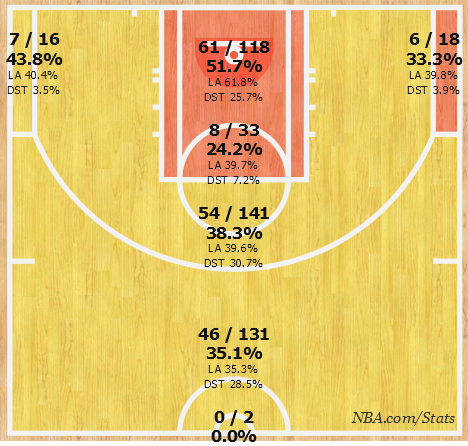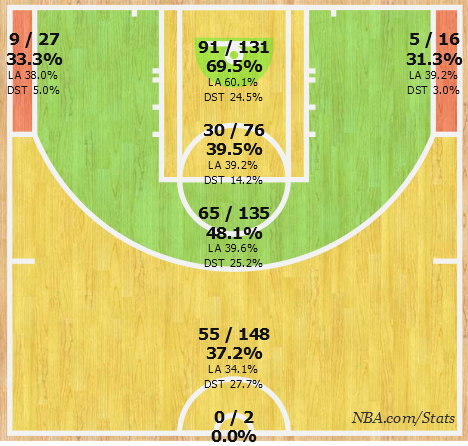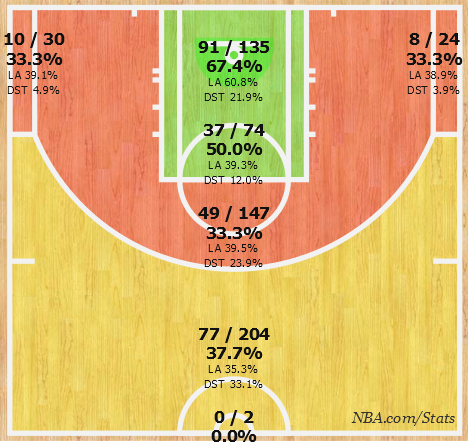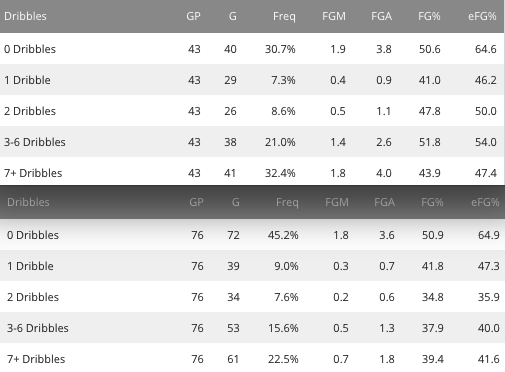Offseason Beat: Fantasy Basketball Mailbag
Can you feel it? Training camp starts next week! No more news about a a guy losing 15 pounds, a guy gaining 10 pounds of muscle, a power forward working on his dribbling, or even a guy dropping fried chicken from his diet.
Anyway, with the Draft Guide ready to roll, we’re going to be doing more stuff on the free side of things. I’ll be doing a mailbag every week.
Here is a terrific quote from George Hill about the lineup from that column:
“We hope so,” Hill said when asked about Mahinmi’s status as the starting center. “I think he deserves it right now, he’s our lone big that’s been here the longest. He’s done a great job when he’s been in the game so far for us with changing the style of play and the speed of the game and doing a great job defensively. I know he’s been working hard this summer to try to step up in that role we’re missing right now from Roy [Hibbert] being gone. Knowing that we’re going to miss Roy a lot but I think Ian will do a great job in trying to fill that void.”
In case you were watching baseball or football this offseason, the move of PG-13 to the four isn’t that surprising. Larry Bird said he’d rather have the boost on the offensive side and possibly take a smaller hit on defense, which does make sense considering how thin they are up front. Vogel did say he could change the lineup throughout the preseason, so definitely keep an eye on it.
People always freak out about a starting lineup and this will probably be overblown. While George is likely to start at the four, I would be surprised to see him play more minutes at the four than the three. That’s a lot of pressure on a guy who broke his leg, and George wasn’t thrilled with this idea earlier this summer. “If I’ve got to play a couple minutes at power forward, I’m fine with it,” George said. He also added he wasn’t expecting to play 30 minutes at that spot, which again would be crazy talk.
For fantasy, I’m not touching George in drafts. Obviously there’s some concern about his leg, but don’t forget he really ran out of gas in his breakout 2013-14 season. In fact, George was just 27th in nine-cat leagues in the second half of his season (that’s 40 of his 80 games, not the All-Star break). Here’s what his shot chart looked like post-break:

Yikes. Those paint numbers are awful, and do you think he is going to see a big improvement around the basket after a dangerous leg injury? Well, he made just 29 percent in the paint last season (14 attempts). This obviously isn’t a big sample, but he’ll likely be off around the basket again. There are just too many other guys I like in the second round to take PG-13. Let someone else draft him.
Let’s say George gets his minutes split right down the middle at the four and three, so that’s 17-18 minutes at the four. That basically means we’ll be looking at a four-man rotation for the rest of the big’s 78-79 minutes: Mahinmi, Jordan Hill, Myles Turner and Lavoy Allen. Mahinmi made six starts last season, averaging 7.5 points, 7.5 boards and 1.0 blocks while somehow making just 1-of-12 from the line in his 24.8 minutes per game. Plus, keep in mind the Pacers were razor thin with only Luis Scola and Lavoy Allen available for all six of those starts. David West, Chris Copeland and Shayne Whittington were there for some of those games, too. The point is that I don’t see Mahinmi playing 25 minutes while the team is healthy and it’ll probably be around 20. He’s also a little injury prone.
That leaves about 58 minutes for Turner, Hill and Allen. I really don’t see Allen getting more than 17 even though his numbers are solid when he logs over 20. He would have to get more minutes at center, but he can’t really protect the rim like Turner or Mahinmi. That would likely put Hill and Turner splitting 40-plus minutes down the middle to start the season. If Turner gets hot, he’ll be taking minutes away from all the other guys, so don’t downgrade him too much. More on him later.
OK, let’s get to the question about Hill and Turner:
George Hill is an interesting case this season. Once he got over what was believed to be a very ominous groin injury, he really got it going last season. In his 43 games, Hill averaged 16.1 points, 4.2 boards, 5.1 assists, 1.0 steals, 0.3 blocks and 1.6 treys. More impressively, he made 47.7 percent from the field on his 12.4 shots per game. That was good for third-round value on the season per game and he was a second-round guy after the break.
Obviously, he was much more involved in the offense thanks to the Pacers being shorthanded. In 2013-14, he averaged 10.3 points, 3.7 boards, 3.5 assists, 0.3 blocks and 1.3 treys on 44.2 percent from the field. Plus, he actually played 2.5 more minutes per game two seasons ago. Perhaps the biggest difference was usage rate: Hill had just a 14.8 usage rate in 2013-14 and it increased all the way to 24.3 last year Wowie. Here’s a comparison of his shot chart in those two seasons starting with 2014-15 at the top:


What a difference, right? He was almost 15 percent better on mid-range while he was better at the rim with a higher distribution. To have that much of a usage increase and be so deadly on those is almost hard to comprehend. Outside of those two massive differences, his efficiency is similar. So why did that happen? Was he open more? Let’s see. Here are his contested shot numbers from at least 10 feet away (last year on top):

He was more efficient on all four instances while he saw tight defense less frequently. He’s more or less an anomaly for being able to get open this much and perhaps some of this credit goes to coach Frank Vogel. Usually, you won’t see a guy with a usage rate near 25 with that many open shots — Not counting Stephen Curry while Russell Westbrook was wide open on 7.8 percent for what it’s worth. On top of that, Hill really put the ball on the floor to score the rock last season. Here are his numbers (last year on top):

On the surface, it’s not hard to figure out why there’s such a massive difference on usage rate. The loss of Paul George and Lance Stephenson explain most of it — they had a combined 47.7 usage rate in 2013-14 with the Pacers. Hill’s time of possession also increased 17 percent per game while his points per touch jumped up an incredible 50 percent. Last year was basically perfect for him and it showed with him dropping elite value down the stretch.
OK, so let’s look forward. Paul George is back and the Pacers added Monta Ellis. Hill was actually able to keep his usage rate to a very solid 22.0 while next to Paul George for 100 minutes last year — George was 29.3 in that time. Perhaps even more impressive is Hill had a 71.4 true shooting percentage next to George. Man, he was good last year, huh?
It’s not just going to be PG-13 because Monta is probably a bigger threat to his usage. Before the Mavs messed up Monta with Rajon Rondo, he posted a 28.8 usage rate while handing out a team-high 4.7 dimes per game. He likes to run the offense and the Pacers bought him to play a similar role to Lance Stephenson in offensive sets. Both Born Ready and Monta thrive in the pick-and-roll. Only two players scored more points in PNR than Monta last year: Damian Lillard and Chris Paul — Monta also ran the PNR more than CP3, but Paul was more efficient. If you also extrapolate Hill’s PNR volume of plays in 43 outings to Monta’s 80 games, Ellis’ total is still 53.7 percent greater. Again, Monta is coming for a reason.
The good news for Hill is that the Pacers are going to run at a faster tempo. This is obviously due to the loss of Roy Hibbert, but should we be buying? Well, with Hibbert off the floor, the Pacers had a pace of 94.0 while that number was just 90.9 with him. Plus, all nine of the Hilbert-less units with at least 60 minutes had a combination of Ian Mahinmi, Luis Scola and David West at the four and five. Not exactly a track-meet group right there. I’d say there’s a very good chance they can get that number to 97-98, which would put them in the top 10. They could definitely dash like Dame. It’s the ROC! Holla!
Alright, so this is a lot of information for a three-word question, but the Pacers are a fascinating team this year. Personally, I’m not drafting Hill and I actually have a side bet with Ryan Knaus (@Knaus_RW) that C.J. McCollum is going to out-produce Hill. If for some reason he slide to around pick 75, I’m definitely willing to grab him, assuming C.J. isn’t on the board 😉.
So what about Myles Turner? If you missed the podcast, Steve Alexander, Aaron Bruski and I had another question about him, so check that out. As mentioned above, Turner is capable of running the floor and so is Jordan Hill, too. For what it’s worth, Hill did run at a 96.9 pace with the Lakers last season and a 98.9 with them in 2013-14. That’s right where the Pacers should be.
So we don’t know much about Turner, but man he is a really nice fit. The bad news is that his Texas Longhorns were just 252nd in pace in the NCAA last year (out of 351), which still is hardly a concern. He doesn’t clog the paint like Hibbert and surprisingly only 23.8 percent of his shot came at the rim last season, but he performed very well at the rim at Summer League. He was also able to make a very impressive 71.7 percent at the rim in college. If he’s going to play the five in a small-ball lineup, having some range is a nice place to start for him to help space.
Another eye-catching stat was he was assisted on just 77 percent of his 3-pointers at Texas. That seems crazy to me. Here are some other interesting stats on him at Texas: Turner made 42.7 percent of his two-point jumpers, was assisted on 64.3 percent of his two-pointers, and perhaps the most important is he made 83.9 percent of his free throws. Turner also had a 25.1 usage rate last season, which is very impressive for a center — that’s basically right in the middle of Okafor (27.6) and Towns (23.7). The scoring side of things is very encouraging on Turner.
While the offense is nice, that’s not his best asset in fantasy. No drafted NBA player in 2015 had a higher block rate than Turner’s 12.3 percent. Not Karl-Anthony Towns (11.5) and not Richaun Holmes (11.1). He managed 2.6 blocks per game in 22.2 minutes per game last year, which is good for 7.5 per 100 possessions.
The block rate stayed hot in Orlando Summer League with 4.3 per game in 29.0 minutes. Turner added 18.7 points, 8.3 rebounds, 0.7 steals and 0.7 treys on 60.5 percent from the field and 80.0 percent from the line. Whew. He won’t touch those numbers in the NBA, but man that is some appetizing info.
The Pacers are also saying that Turner is going to play “a lot” to start the season. Yes, Paul George is going to play several minutes at the four and probably start, so we’re probably not going to see Turner get more than 24 minutes per game right out of the gate as long as Jordan Hill or Mahinmi are healthy.
As said on the pod, I like Turner in the 100-110 range for standard leagues. If I’m in a shallow league, I might even be willing to jump up to 90 and I might take him there if I really missed the boat on a big — do NOT miss the boat on a big, by the way. His upside is just way too high and I’m not too concerned about the injury issues. He slipped to 11 in the NBA Draft because of a weird walking gait, which you could kind of see at Summer League. But again, scared money don’t make money. His opportunity is huge.
That does it for this week!
This entry passed through the Full-Text RSS service – if this is your content and you’re reading it on someone else’s site, please read the FAQ at fivefilters.org/content-only/faq.php#publishers.